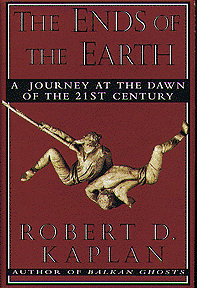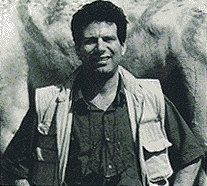

 Robert
D. Kaplan is a contributing editor of The Atlantic Monthly, published in
Boston. His latest book,The
Ends of the Earth (Randon House, $27.50), includes a chapter on
his observations during recent travels in Iran. His previous book, Balkan
Ghosts: A Journey Through History was chosen by The New York Times Book
Review as one of the best books of 1993. The following is from pages 180-82
of Ends of the Earth.
Robert
D. Kaplan is a contributing editor of The Atlantic Monthly, published in
Boston. His latest book,The
Ends of the Earth (Randon House, $27.50), includes a chapter on
his observations during recent travels in Iran. His previous book, Balkan
Ghosts: A Journey Through History was chosen by The New York Times Book
Review as one of the best books of 1993. The following is from pages 180-82
of Ends of the Earth.
It was nighttime, humming with the sound of fresh water tinkling over rocks.
Mr. [Asghar] Kashan [the friend of someone I know in the Iranian government]
and I were walking along the banks of the Darband River, which flows down
from the Elborz at the northern extremity of Teheran.
We passed a number of teahouse restaurants until we found one that we especially liked. Here Iran revealed its closeness to Central Asia. Along with the orchids, tulips and roses, bubbling water pipes, and a flute player were the carpets on raised platforms where people ate, as in the Central Asian chai-khanas, or teahouses.
On these carpets, leaning against brocaded pillows under the glow of colored lights strung overhead, men and women smoked, held hands, whispered, and flirted. Intrigued, I stared at a woman in a black chador, who returned my stare, a challenge. Mr. Kashan noticed this and smiled, again, as if to say: You see, we are not, exactly, as we are portrayed in the West. Consider the women, for example.
Indeed. My first impression in Iran was that the female half of the population was draped in shapeless black. But after a few hours my eyes began to adjust to the distinctions... Most were black, but not all. Yes, this was only the beginning.
Some women displayed bits of forbidden hair along with flashy earrings, others wore kohl beneath their eyes, and, in not a few cases, lipstick. Many had finely manicured hands with long red fingernails. Many women also used perfumes; occasionally I noticed an expensive French scent, which, unlike flowers in the cheap odor of incense, gave off a provocative animal aroma.
Driving through the traffic toward the Darband River on this, my first evening in Teheran, I noticed that many of the Iranian drivers were women, liberally using their horns and shouting from their car windows, badgering other drivers to speed up. What a difference from Saudi Arabia, America's ally in the Moslem world, where women aren't allowed to drive.
I saw one Iranian woman draped in black driving a motorcycle. Another rode on a motorbike behind her boyfriend, holding him tightly around the waist, and at the stoplight I could see that they had begun to hold hands, engaging in an erotic finger-play.
Women in Teheran stare you in the face. Their eyes meet you dead-on. Cairo has little of this, and Istanbul much less than Teheran... In Iran, a male traveler communicated with both sexes, not just with his own.
In Iran, you could point a camera at a woman -- as I often did -- and she would smile... In Iranian homes, even lower-middle-class homes, where women remained in chador, women still talked to you, questioned you, and did not politely retreat.
The Islamic Revolution was supposed to have been cultural as well as political. The chador, coupled with the giant posters reading Marg bar Amrika ("Death to America"), were visual evidence of this dual purpose.
Yet the mores of what was, by Near Eastern standards, a highly sophisticated, urbane, and even northern culture, appeared minimally affected fifteen years after the revolution, or even twenty years later, at the time of my last visit to Teheran.
Women, as I was to see, crowded the fancy clothing boutiques in north Teheran and the less fancy ones elsewhere in the city: Uniformity outside of the home served only to increase fashion consciousness inside.
Iranian women would not be turned into peasants. And as public life had been circumscribed, I observed that, as in the Eastern Europe I knew well during the communist era, private life here had become richer in order to compensate.
You can purchase "The Ends of the Earth" from Amazon.com, the world's largest online bookstore. THE IRANIAN is an associate of Amazon.com. Click here.
Related links
* Travelers section
* WebGuide Travel
section
* Bookstore
* Cover Stories
* Who's
who


